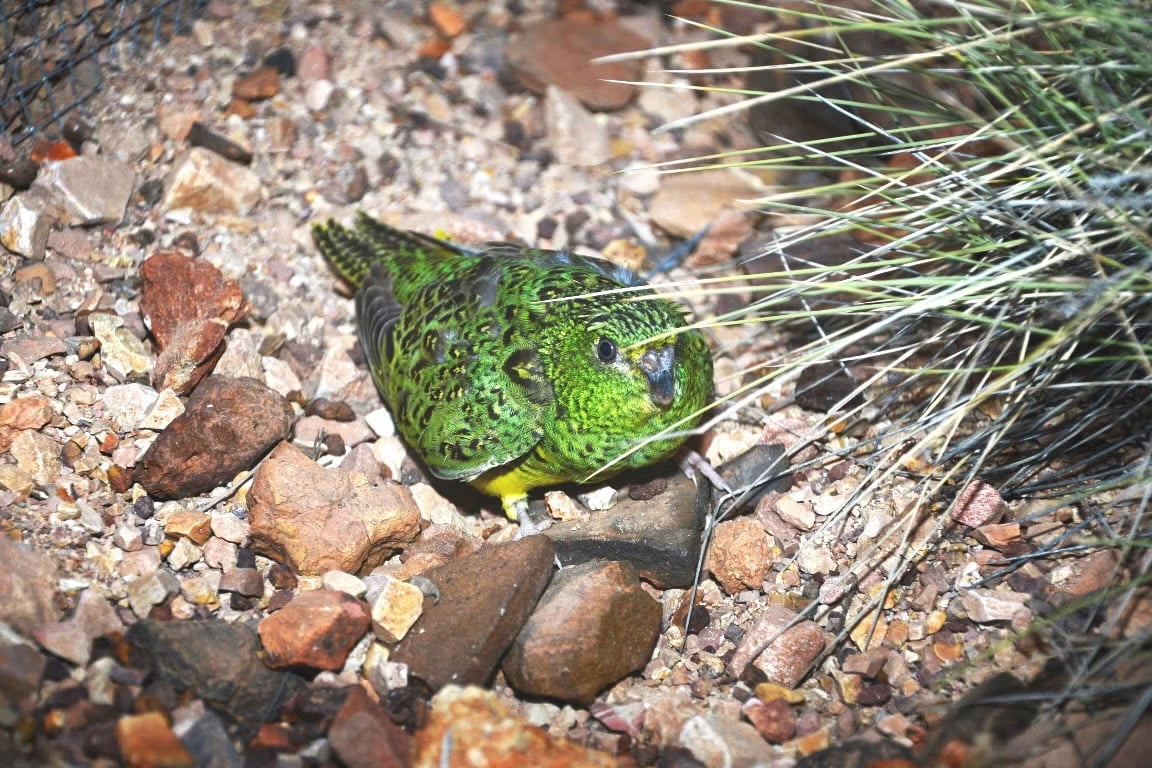The Search for the Night Parrot
Between 2020 and 2023, Indigenous rangers and scientists worked together to locate the parrots. They placed durable audio recorders across dozens of desert sites. These devices captured the bird’s unique calls, described as sounding like digital beeps or distant bells.
When recordings confirmed the parrots’ presence, the team followed up with motion-triggered cameras. They also collected animal scat to study predators and analyzed decades of satellite data to track fire patterns.
Where the Night Parrot Lives
Audio evidence showed that night parrots used more than half of the surveyed sites. This meant they weren’t just wandering individuals, but part of a real population.
The birds roosted deep in bull spinifex (Triodia longiceps), a tough desert grass that grows in dome-shaped clumps. Older, denser clumps provide the shade and protection parrots need. Younger growth doesn’t work as well.
This is why fire matters so much. If fires happen too often, spinifex never matures, leaving parrots without safe shelter.
The Role of Fire
Desert fires, often sparked by lightning, sweep quickly through dry landscapes. If they occur too frequently, the land remains in an early-growth phase, unsuitable for parrots.
Researchers found that roosting areas were burning too often. The solution? Cool, carefully planned burns led by Indigenous rangers. These create a patchwork of burned and unburned land, reducing the risk of massive, destructive fires while preserving mature spinifex.
Predators: Friend and Foe
Cameras caught images of dingoes, which seemed like a threat at first. But scat analysis revealed a surprise: cats were the bigger problem. Feral cats hunt at night and are deadly to young parrots.
Dingoes actually help by keeping cat populations in check, either through hunting or by making hunting grounds less safe for cats. Areas with active dingoes had fewer cats—and better survival chances for parrots.
How Many Night Parrots Are There?
Based on calls and observations, the team estimated about 50 night parrots in this part of Ngururrpa. It may sound small, but for such a rare bird, it’s a crucial stronghold.
Still, this population is fragile. Fires, predators, and disturbances from vehicles or livestock could quickly tip the balance.
Protecting the Future
To safeguard night parrots, experts recommend:
- Using Indigenous-led fire management guided by satellite data
- Protecting dingoes to help control cat populations
- Keeping roosting areas quiet and undisturbed
- Preventing invasive weeds and livestock damage
- Using DNA testing and tracking tags to learn more about parrot movements
A Lesson in Teamwork
This project shows what’s possible when science and Indigenous knowledge work hand-in-hand. The night parrot’s survival depends on mature spinifex, balanced predators, and careful fire planning.
Thanks to these efforts, even one of Australia’s most mysterious birds now has a chance to thrive.
FAQs
Where does the night parrot live?
In mature spinifex grass in Australia’s deserts.
What do night parrots need to survive?
Old spinifex, safe roosts, and protection from predators.
Are dingoes harmful to night parrots?
No. Dingoes actually help by limiting cat populations.
How many night parrots live in Ngururrpa?
Around 50 have been estimated in the region.
What are the main threats to the night parrot?
Frequent fires, feral cats, and human disturbance.
Final Thoughts
The night parrot reminds us how fragile—and how resilient—nature can be. By combining traditional wisdom with modern science, we can protect even the rarest species. Next time you think of Australia’s vast deserts, remember: some of its greatest secrets only come out at night.
